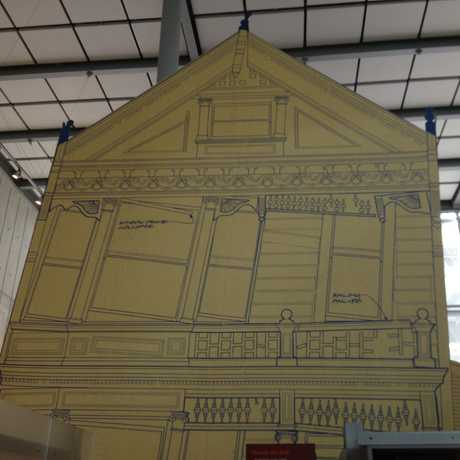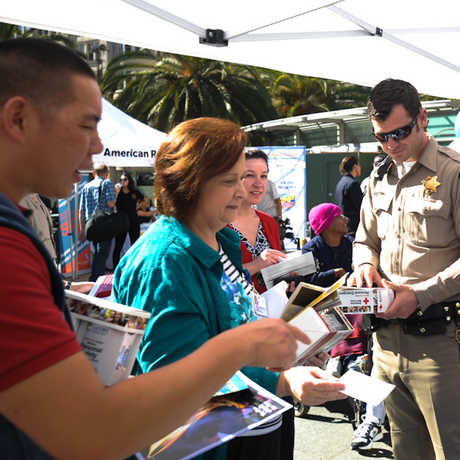Get a new perspective on earthquakes with this rich collection of multimedia resources. You'll learn why earthquakes happen, how they've shaped the Bay Area, and what you can do to prepare for the next one.
DIY Science
How to Prepare for an Earthquake
Earthquakes happen without warning. We don’t know when the next major earthquake will happen, but we can take action now to prepare to survive it and minimize impact. Preparedness starts with a plan. For cities and agencies, this means working with engineers to retrofit older structures and design new buildings, bridges, and highways to withstand an earthquake as best as possible. For individuals and families, this means putting together an earthquake preparedness plan and kit and knowing what to do before, during, and after an earthquake.
Before: Are You Ready for a Rumble?
Earthquakes strike suddenly, violently, and without warning. Identifying potential hazards ahead of time and planning in advance can reduce the dangers of serious injury or loss of life from an earthquake. Repairing and reinforcing building foundations, anchoring overhead lighting fixtures to the ceiling, securing furniture and other objects to walls and floors, and following local seismic building standards will help reduce the impact of earthquakes.
Many injuries suffered during earthquakes result from items falling or shifting due to the shaking of the earth. Identifying potential hazards prior to an earthquake can protect you and your family. Do an inventory of your house and where you work. Anything that can move or fall during a quake should be placed in a closed cabinet or a secondary container. Anything that can’t be put elsewhere should be securely fastened down or, for objects such as bookcases, attached to the wall. Avoid hanging pictures or mirrors near beds or places where people sit.
After an earthquake, you might not have access to water, food, electricity, or other necessities for up to a week. Creating a disaster supply kit will help you get through the aftermath of an earthquake. Store enough water, food, and other basic items to meet your needs for at least 72 hours. Keep the kit in a place where you spend most of your time so that it will be easily accessible if an earthquake strikes.
It is also a good idea to develop an emergency communication plan. Do not rely on cell phones or other devices that require electricity. Develop a plan for reuniting after the disaster in case family members are separated from one another during an earthquake. Ask an out-of-state relative or friend to serve as the family contact. After a disaster, it's often easier to call long distance than locally. Make sure everyone in the family knows the name, address and phone number of the contact person.
Six Ways to Plan Ahead
1. Check for Hazards in the Home
- Fasten shelves securely to walls.
- Place large or heavy objects on lower shelves.
- Store breakable items such as bottled foods, glass, and china in low, closed cabinets with latches.
- Hang heavy items such as pictures and mirrors away from beds, couches, and anywhere people sit.
- Brace overhead light fixtures.
- Repair defective electrical wiring and leaky gas connections. These are potential fire risks.
- Secure a water heater by strapping it to the wall studs and bolting it to the floor.
- Repair any deep cracks in ceilings or foundations. Get expert advice if there are signs of structural defects.
- Store weed killers, pesticides, and flammable products securely in closed cabinets with latches and on bottom shelves.
2. Identify Safe Places Indoors and Outdoors
- Under sturdy furniture such as a heavy desk or table.
- Against an inside wall.
- Away from where glass could shatter around windows, mirrors, pictures, or where heavy bookcases or other heavy furniture could fall over.
- In the open, away from buildings, trees, telephone and electrical lines, overpasses, or elevated expressways.

3. Educate Yourself and Family Members
- Contact your local emergency management office or American Red Cross chapter for more information on earthquakes. Also read the "How-To Series" for information on how to protect your property from earthquakes.
- Teach children how and when to call 9-1-1, police, or fire department and which radio station to tune to for emergency information.
- Teach all family members how and when to turn off gas, electricity, and wate
4. Have Disaster Supplies on Hand
- Flashlight and extra batteries
- Portable, battery-operated radio and extra batteries
- First aid kit and manual
- Emergency food and water
- Nonelectric can opener
- Essential medicines
- Cash and credit cards
- Sturdy shoes
5. Develop an Emergency Communication Plan
-
Make a plan for reuniting after the disaster in case family members are separated from one another during an earthquake (a real possibility during the day when adults are at work and children are at school).
- Ask an out-of-state relative or friend to serve as the "family contact." After a disaster, it's often easier to call long distance. Make sure everyone in the family knows the name, address, and phone number of the contact person.
6. Help Your Community Get Ready
-
Publish a special section in your local newspaper with emergency information on earthquakes. Localize the information by printing the phone numbers of local emergency services offices, the American Red Cross, and hospitals.
-
Conduct a week-long series on locating hazards in the home.
-
Work with local emergency services and American Red Cross officials to prepare special reports for people with mobility impairments on what to do during an earthquake.
-
Provide tips on conducting earthquake drills in the home.
-
Interview representatives of the gas, electric, and water companies about shutting off utilities.
- Work together in your community to apply your knowledge to building codes, retrofitting programs, hazard hunts, and neighborhood and family emergency plans.
What to Do During an Earthquake
Stay as safe as possible during an earthquake. Be aware that some earthquakes are actually foreshocks, and a larger earthquake might occur. Minimize your movements to a few steps to a nearby safe place.
If you are indoors, you should drop, cover, and hold—drop to the ground, find cover under a table or other sturdy piece of furniture, and hold on until the shaking stops. If there isn’t a table nearby, move to a corner or inside part of the building, away from glass, and stay on the floor with your arms covering your head.
Stay inside until the shaking has stopped and you are sure exiting is safe. Once outside, move away from buildings to an open space.
What to Do After an Earthquake
After an earthquake, it is most important to get to a safe location. Take your disaster supplies kit with you. Check for injuries and hazards, then help others. Once you are safe, follow the emergency earthquake plan that you have prepared to communicate and reconnect with family members.
This post is part of Exploring Earthquakes, a rich collection of resources co-presented by the California Academy of Sciences and KQED. This material is also available as a free iBooks textbook and iTunes U course.
Don’t miss California: State of Nature, an interactive exhibit at the Academy exploring our state's interconnected ecosystems—and featuring the Shake House, an earthquake simulator.
Ideas for using videos, articles, and infographics about earthquakes in the classroom.


